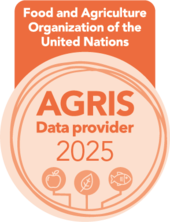Especies de arañas como agentes de control biológico natural de la “cigarrita marrón” (Tagosodes orizicolus Muir) en el cultivo de arroz en el valle de Tumbes
DOI:
https://doi.org/10.17268/manglar.2021.021Resumen
Las arañas son parte de la fauna benéfica presente en los agroecosistemas de arroz en Tumbes y cumplen un rol fundamental como agentes de biocontrol de Tagosodes orizicolus Muir. Se hace necesario conocer su biodiversidad para integrarlas en el manejo integrado de plagas. El objetivo del estudio fue identificar las especies y sus fluctuaciones poblacionales en el cultivo de arroz en el valle de Tumbes. El primer periodo de evaluación fue durante octubre 2018 a enero 2019 en cultivos sembrados bajo la modalidad de trasplante y de abril a junio de 2019 de siembra directa. Las colectas fueron semanales, las técnicas de colecta fueron trampas de caída, observación directa en un determinado número de plantas por m2 y barrido con red entomológica. El material colectado fue llevado a los ambientes del museo entomológico para su procesamiento, identificación y conservación. Se recolectaron ejemplares pertenecientes a 18 familias, las más representativas fueron Lycosidae (65,05%), Tetragnathidae (15,15%) y Oxyopidae (6,48%). Se identificaron 37 especies y/o morfoespecies. Las más abundantes fueron Hogna albemarlensis (45,57%), Arctosa minuta (12,46%) y Tetragnatha nitens (10,63%). Este estudio representa la primera contribución al conocimiento de la diversidad de arañas presentes en el cultivo de arroz en el valle de Tumbes.
Descargas
Referencias
Aguilera, M. A. & Casanueva, M. E. (2005). Arañas chilenas, estado actual del conocimiento y clave para las familias de Araneomorphae. Gayana 69(2),201-224.
Almada, M., Sosa, M. & González, S. (2012). Araneofauna (Arachnida, Araneae) en cultivos de algodón (Gossypium hirsutum) transgénicos y convencionales en el norte de Santa Fe, Argentina. Revista de Biología Tropical. 60(2), 611-623.
Amalin, D. M., Peña, J. E., Mcsorley, R., Browning, H. W. & Crane, J. H. (2001). Comparison of different sampling methods and effect of pesticide application on spider population in lime orchards in south Florida. Environ. Ent., 30, 1021-1027.
Avalos, G., Bar, M., Oscherov, E. & González, A. (2013). Diversidad de Araneae en cultivos de Citrus sinensis (Rutaceae) de la Provincia de Corrientes, Argentina. Revista de Biología Tropical. 61(3), 1243-1260.
Backus, E. A., Serrano, M. S. & Ranger, C. M. (2005). Mechanisms of hopperburn, an overview of insect taxonomy, behavior, and physiology. Annu. Rev. Entomol. 50, 125–151.
Baert, L. & Maelfait, J. P. 1986. A contribution to the knowledge of the spider fauna of Galápagos (Ecuador). Bulletin van het Koninklijk Belgisch Instituut voor Natuurwetenschappen, Entomologie, 56, 93-123.
Baert, L., Maelfait, J.P. & Hendrickx, F. (2008). The wolf spiders (Araneae, Lycosidae) from the Galápagos Archipelago. Bulletin de l'Institut Royal des Sciences Naturelles de Belgique, Entomologie 78, 5-37.
Bambaradeniya, C.N.B., Edirisinghe, J.P., Hendrickx, De Silva, D.N., Gunatilleke, C.V.S., Ranawana, K.B. & Wijekoon, S. (2004). Biodiversity associated with an irrigated rice agro-ecosystem in Sri Lanka. Biodiversity and Conservation 13, 1715-1753.
Bao, L., Ginella, J., Cadenazzi, M., Castigglioni, E., Martinez, S., Casales, L., Caraballo, M., Laborda, A. & Simo, M. (2019). Spider assemblages associated with different crop stages of irrigated rice agroecosystems from eastern Uruguay. Biodiversity Data Journal 6, e24974.
Bastidas, H., Pantoja, A., Murillo, A., Zuluaga, J. I. & Duque, M. C. (1994). Reconocimiento, fluctuación y pruebas de consumo de presas por arañas en cultivos de arroz, en el valle del Cauca. Revista Colombiana de Entomología 20(3),149-160.
Butt, A. & Tahir, H. (2010). Resource partitioning among five agrobiont spiders of a rice ecosystem. Zoological Studies 49(4), 470-480.
Cuevas, A. (1994). Las arañas, Controladores naturales de insectos fitófagos en el cultivo de arroz en Norte de Santander. Revista Colombiana de Entomología 2083), 179-186.
Fritz, L., Arden, E., Pandolfo, M., Martins, S., Vargas, J. & Fiuza, L. (2008). Agroecosistemas orizicolas irrigados, Insetos-Praga, Inimigos Naturais. Oecol. Bras.12 (4), 720- 732.
Gutaker, R. M., Groen, S. C., Bellis, E. S., Choi, J. Y., Pires, I. S., et al. (2020). Genomic history and ecology of the geographic spread of rice. Nat. Plants 6, 492-502.
Huffaker, C. B. & Messenger, P. S. (1976). Theory and practice of biological control. New York, Academic Press.
Jocqué, R. & Dippenaar-Shoeman, A. S. (2006). Spider families of the world. Tervuren, Belgium, Royal Museum for Central Africa. 336 p.
Jayakumar, S. & Sankari, A. (2010). Spider population and their predatory efficiency in different rice establishment techniques in Aduthural, Tamil Nadu. Journal Biopesticides 3 (1 Special Isuue) 020-027.
Kaston, B. J. (1970). How to know the spiders? WM. C. Brown Company Publishers Dubuque, Iowa. 220 pp.
Katti, G., Pasalu, I. C., Varma, N. R. G. & Dhandapani, N. (2001). Quantification of natural biological control in rice ecosystem for possible exploitation in rice IPM. Indian Journal of Entomology 63,439-448.
Levi, H. W. (2002). Keys to the genera of araneid orbweavers (Araneae, Araneidae) of the Americas. Journal of Arachnology, 30,527–562.
Liu, W. X., Hou, M. L., Wan, F. H. & Wang, F. L. (2003). Temporal and spatial niche dynamics of spiders and their control effects on cotton bollworms in transgenic Bt. cotton fields. Entomol. Know., 40,160- 163.
Liu, W., Hajano, J. U. & Wang, X. (2018). New insights on the transmission mechanism of tenuiviruses by their vector insects. Curr. Opin. Virol. 33, 13–17.
Martin, J. E., Bernal E. K., Cruz, M. G., Zhu-Salzman K., Way M. O. & Badillo-Vargas, I. E. (2019). Assessing the Potential Infection of Tagosodes orizicolus (Hemiptera, Delphacidae) by Rice Hoja Blanca Virus in Texas Journal of Economic Entomology, 113(2), 1018-1022 - November 2019
Ministerio de Agricultura y Riego-MINAGRI. (2019). Encuesta nacional de intenciones de siembra 2019. Lima, Perú, Dirección general de seguimiento y evaluación de políticas dirección de estadística agraria
Ministerio de Agricultura y Riego-MINAGRI. (2020). Plan Nacional de Cultivos Campaña Agrícola 2019- 2020. Lima, Perú, Dirección general de seguimiento y evaluación de políticas dirección de estadística agraria.
Morales, F. J. & Jennings, P. R. (2010). Rice Hoja Blanca, a complex plant– virus–vector pathosystem. CAB Rev. 5, 1–15.
Pérez-Guerrero, S., Tamajón, R., Aldebis, H. & Vargas-Osuna, E. (2009). Comunidad de arañas en cultivos de algodón ecológico en el sur de España. Revista colombiana de Entomología. 35(2), 168-172.
Rodrigues, E. N. L., de S. Mendonca, M. & Ott, R. (2008). Fauna de aranhas (Arachnida, Milton Araneae) em diferents estagios do cultivo do arroz irrigado em Cachoeirinha, RS, Brasil. Iheringia, Sér. Zool. Porto Alegre. 98(3), 362-371.
Rodrigues, E., de Mendonca, M., Fritz, L. L., Heinrichs, E. A. & Fiuza, L. (2013). Effect of the insecticide Lambda-cyhalotrina on rice spider populations in southern Brazil. Zoología 30(6), 615-622.
Rodrigues, E. N. L., M.S. Mendonca, J. R. & Ott. R. (2009). Spider diversity in a rice agroecosystem and adjacent areas in southern Brazil. Revista Colombiana de Entomología 35, 78-86.
Rodrigues, E. N. L., Podgaiski, L. R., Ott, R., Oliveira, J. V. & JR, M. M. (2005). Aranhas e suas formas de predacao na cultura de arroz irrigado (Oryza sativa) na Depresao Central, RS. pp, 31-32. Anais do IV Congresso Brasileiro de Arroz irrigado, Santa María. 658 pp.
Rubio, G. D., Minoli, I. & Piacentini, L. (2007). Patrones de abundancia de cinco especies de arañas lobo (Araneae, Lycosidae) en dos ambientes del Parque Nacional Mburucuyá, Corrientes, Argentina. Brenesia, 67, 59-67.
Ryptstra, A. L., Carter, P.E., Balfour, R.A. & Marshall, S.D. (1999). Architectural feature of agricultural habitats and their impacto in the spider in habitants. Journal of Arachnology 27(1), 371-377.
Shawer, M. B., Sharshir, F. A., Hendawy, A. S. & Refaei, E. A. (2012). Survey of True Spiders in the Egyptian Rice Fields at Rasheid Region Beheira Gavarnarte. J. Plant Prot. and Path., Mansoura Univ., Vol. 3 (8), 835 – 842.
Shepard, B. M., Barrion, A. T. & Litsinger, J. A. (1987). Friends of the Rice Farmer, Helpful Insects, Spiders, and Pathogens. International Rice Research Institute. Los Baños, Laguna, Philippines. 127 pp.
Sudhikumar, A., Mundackatharappel, J., Enathayil, S. & Pothalil, A. (2005). Seasonal variation in spider abundance in Kuttanad rice agroecosystem, Kerala, India (Araneae). European Arachnology 2005 (Deltshev, C. & Stoev, P., eds) Acta zoologica bulgarica, Suppl. No. 1, pp. 181-190.
Tahir, H. & Butt, A. (2009). Effects of Different Management Practices and Field Margins on the Abundance of Ground Spiders in Rice Ecosystems. J. Zool., 41(2), 85-93.
Thorbek, P. & Bilde, T. (2004). Declines of generalist arthropod predators due to mortality, emigration, or habitat disruption after tillage and grass cutting. Journal of Applied Ecology 41, 526‑538.
Thorbek, P. & Topping, C. J. (2005). The influence of landscape diversity and heterogeneity on spatial dynamics of agrobiont linyphiid spiders, an individual-based model. BioControl, 50, 1‑33.
Tikader, B. K. & Malhotra, M. S. (1980). Lycosidae (Wolf spiders). Fauna India (Araneae), 1, 248-447.
Uetz, G. W., Halaj, J. & Cady, A. B. (1999). Guild Structure of Spiders In Major Crops (1999). The Journal of Arachnology 27, 270-280.
Van Groenigen, K. J., van Kessel, C. & Hungate, B. A., (2013). Increased greenhouse-gas intensity of rice production under future atmospheric conditions. Nat. Clim. Chang. 3, 288-291.
Vijaykumar, P. B. V. (2004). Spider fauna of paddy ecosystem in selected areas of Tungabhadra Project in Karnataka. Journal of Agricultural Sciences 17 (3), 584-585.
Vinothkumar, B. (2012). Diversity of spider fauna in upland rice agroecosystem at Gudalur valley in Tamilnadu. Journal of Biological Control, 26 (3), 222–229.
Vivas-Carmona, L. E. & Astudillo-García, D.H. (2017). Cuatro especies de arácnidos (Arachnida, Araneae) en arrozales de Calabozo Estado Guárico, Venezuela. J. Selva Andina Biosphere 5(2),116-123.
World Spider Catalog. Version 21.0. (2019). Natural History Museum Bern, online at http://wsc.nmbe.ch, (acceso 15/12/2019).
World Spider Catalog. Version 21.0. (2020). Natural History Museum Bern, online at http://wsc.nmbe.ch, (acceso 15/02/2020).
Publicado
Número
Sección
Licencia
Derechos de autor 2022 Pedro S. Castillo-Carrillo, Pedro G. Calle-Ulfe, Jean C. Silva-Alvarez

Esta obra está bajo una licencia internacional Creative Commons Atribución 4.0.

Manglar is an open access journal distributed under the terms and conditions of Creative Commons Attribution 4.0 International license









